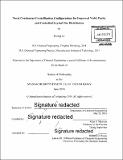| dc.contributor.advisor | Allan S. Myerson. | en_US |
| dc.contributor.author | Li, Jicong, Ph. D. Massachusetts Institute of Technology | en_US |
| dc.contributor.other | Massachusetts Institute of Technology. Department of Chemical Engineering. | en_US |
| dc.date.accessioned | 2016-09-13T19:12:51Z | |
| dc.date.available | 2016-09-13T19:12:51Z | |
| dc.date.copyright | 2016 | en_US |
| dc.date.issued | 2016 | en_US |
| dc.identifier.uri | http://hdl.handle.net/1721.1/104210 | |
| dc.description | Thesis: Ph. D., Massachusetts Institute of Technology, Department of Chemical Engineering, 2016. | en_US |
| dc.description | Cataloged from PDF version of thesis. | en_US |
| dc.description | Includes bibliographical references. | en_US |
| dc.description.abstract | Continuous crystallization process has potential advantages such as lower cost and improved flexibility in pharmaceutical production when compared to batch crystallization. A good continuous crystallization process should achieve a high product yield and purity comparable to current batch crystallization processes. The aim of this thesis is to develop novel continuous crystallization process to enhance the final yield while control the quality of the crystal product. Three different approaches were studied: (1) the use of continuous solids recycle to enhance the yield by increasing the crystal surface area and total crystal mass deposition; (2) the optimization of multistage continuous mixed-suspension, mixed-product removal (MSMPR) crystallization to minimize the number of stages and total residence time; (3) the combination of impurity complexation and organic solvent nanofiltration to remove the impurity that has similar molecular weight and structure to the active pharmaceutical ingredient (API). For the first two approaches, continuous crystallization processes of cyclosporine were developed. The first method, solids recycle, successfully increased the surface area of crystals in the crystallizer thus increasing the mass deposition rate. With solids recycle to the second stage and both stages, 75.3% and 79.8% in yield were achieved, respectively. The product purity remained the same while the yield was enhanced. The second method proved that optimization of stage conditions could help obtain high yield and purity within short residence time. Different behaviors of the impurities were investigated and the impurity distribution model helped estimate the highest product purity achievable of the process. The results showed that optimization in stage number and stage temperatures could improve the yield close to the batch yield at equilibrium. In the third method, fenofibrate and fenofibric acid system with 1,3-di-otolylguanidine (DOTG) as complexing agent was studied. Complexing agent firstly formed hydrogen bonds with the impurity specifically, thus reduced the structure similarity of the API and impurity. It became more difficult for the impurity molecules to incorporate into the API crystal lattice. Then organic solvent nanofiltration membrane separated the API and complex in the mother liquor. By recycling the purified mother liquor back to the crystallizer, the final yield of the process was improved. | en_US |
| dc.description.statementofresponsibility | by Jicong Li. | en_US |
| dc.format.extent | 110 pages | en_US |
| dc.language.iso | eng | en_US |
| dc.publisher | Massachusetts Institute of Technology | en_US |
| dc.rights | M.I.T. theses are protected by copyright. They may be viewed from this source for any purpose, but reproduction or distribution in any format is prohibited without written permission. See provided URL for inquiries about permission. | en_US |
| dc.rights.uri | http://dspace.mit.edu/handle/1721.1/7582 | en_US |
| dc.subject | Chemical Engineering. | en_US |
| dc.title | Novel continuous crystallization configurations for improved yield, purity and controlled crystal size distribution | en_US |
| dc.type | Thesis | en_US |
| dc.description.degree | Ph. D. | en_US |
| dc.contributor.department | Massachusetts Institute of Technology. Department of Chemical Engineering | |
| dc.identifier.oclc | 958138857 | en_US |
